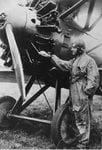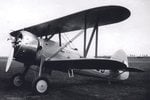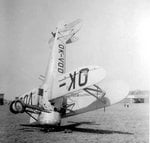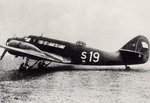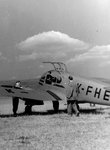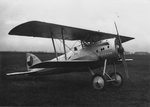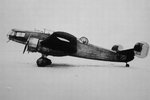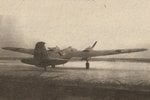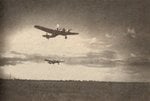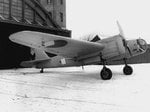The Czech Air Force, ICAO code CEF, is the air force branch of the Armed Forces of the Czech Republic. The Air Force, with the Ground Forces, comprises the main combat power of the Armed Forces of the Czech Republic. It is a successor of the Czechoslovak Air Force (up to 1992). During the inter-war period a modern nation surrounded by potentially hostile neighbors, without access to the ocean, the Czechoslovak leadership needed to build a capable air force. So was born the motto "Air is our sea". The Czechoslovak government between the wars balanced a home-grown aviation industry with licensing engine and aircraft designs from allied nations. Several major aircraft companies, and a few engine companies, thrived in Czechoslovakia during the 1930s. One well-known engine manufacturer was A. S. Walter located in Prague.
The Aero Company (Aero továrna letadel), was located in the Vysočany quarter of Prague. Its mixed construction (wood, metal and fabric covering) and all-metal aircraft were competitive in the early 1930s; however, by 1938, only its MB.200 (a licensed Bloch design) was not totally obsolete. Aero A-30The Avia Company (Avia akciová společnost pro průmysl letecký Škoda), a branch of the enormous Škoda Works (Škodovy závody) for heavy machinery and defence industrial organization, was different. Founded in 1919 in an old sugar factory in the eastern Prague suburbs of Letňany and Čakovice, Avia made entire airplanes, including motors, which were usually licensed Hispano-Suiza designs. The standard Czechoslovak pursuit plane of the late 1930s, the B-534 reached a total production of 514 units. It was one of the last biplane fighters in operational use, and also one of the best ever produced. The state-controlled Letov (Vojenská továrna na letadla Letov) was also situated in Letňany. It employed about 1,200 workers in the late 1930s, and it manufactured the Š-328 biplane, of which over 450 were produced. The entire airframe was welded together, not bolted or riveted. The Letov factory was the only Czechoslovak plant that manufactured metal propellers.
Shortly after the German occupation on 15th March 1939, the Czechoslovak Air Force disbanded. A lot of pilots decided to leave the republic and fight against the enemy abroad. The first country where they tried to fight was Poland. Some were accepted into the Polish Air Force while the rest of the airmen sailed to France. The short Polish war gave us the most famous four pilots Balejka, Frantisek, Kosar and Pavlovic. The next country where Czechoslovak airmen fought was France. There were tens of airmen posted to French air units, mainly fighter pilots. Two Czech fighters - Vasatko (15 victories) and Perina (14 victories) became famous in "The Battle of France". Twenty Five Czechoslovaks we killed during dogfights over France. After the fall of France, airmen evacuated to the last country which was still fighting against Germany - Great Britain.
Czechoslovak airmen joined The Royal Air Force Volunteer Reserve and they created two Czechoslovak air units in 1940 - Nos. 310 and 311. No 310 was a Czechoslovak Fighter Squadrons and No. 311 was a Czechoslovak Bomber Squadron. At all 88 Czechoslovak fighters took part in the "Battle of Britain" and Sgt Josef Frantisek became very famous with 17 victories which were claimed during one month. The last Czechoslovak air unit, No. 313 Czechoslovak Fighter Squadron, was created in 1941 and one flight of No. 68 Night Fighter Squadron became Czechoslovak in 1942. Many of the Czechoslovak airmen had served during the entire war at many british squadrons and non-operational units. There were more than 2500 Czechoslovaks who joined the RAF and more then 500 of them were killed. All Czechoslovak squadrons returned to Czechoslovakia in August 1945 where they were transformed for peace time service.
The Aero Company (Aero továrna letadel), was located in the Vysočany quarter of Prague. Its mixed construction (wood, metal and fabric covering) and all-metal aircraft were competitive in the early 1930s; however, by 1938, only its MB.200 (a licensed Bloch design) was not totally obsolete. Aero A-30The Avia Company (Avia akciová společnost pro průmysl letecký Škoda), a branch of the enormous Škoda Works (Škodovy závody) for heavy machinery and defence industrial organization, was different. Founded in 1919 in an old sugar factory in the eastern Prague suburbs of Letňany and Čakovice, Avia made entire airplanes, including motors, which were usually licensed Hispano-Suiza designs. The standard Czechoslovak pursuit plane of the late 1930s, the B-534 reached a total production of 514 units. It was one of the last biplane fighters in operational use, and also one of the best ever produced. The state-controlled Letov (Vojenská továrna na letadla Letov) was also situated in Letňany. It employed about 1,200 workers in the late 1930s, and it manufactured the Š-328 biplane, of which over 450 were produced. The entire airframe was welded together, not bolted or riveted. The Letov factory was the only Czechoslovak plant that manufactured metal propellers.
Shortly after the German occupation on 15th March 1939, the Czechoslovak Air Force disbanded. A lot of pilots decided to leave the republic and fight against the enemy abroad. The first country where they tried to fight was Poland. Some were accepted into the Polish Air Force while the rest of the airmen sailed to France. The short Polish war gave us the most famous four pilots Balejka, Frantisek, Kosar and Pavlovic. The next country where Czechoslovak airmen fought was France. There were tens of airmen posted to French air units, mainly fighter pilots. Two Czech fighters - Vasatko (15 victories) and Perina (14 victories) became famous in "The Battle of France". Twenty Five Czechoslovaks we killed during dogfights over France. After the fall of France, airmen evacuated to the last country which was still fighting against Germany - Great Britain.
Czechoslovak airmen joined The Royal Air Force Volunteer Reserve and they created two Czechoslovak air units in 1940 - Nos. 310 and 311. No 310 was a Czechoslovak Fighter Squadrons and No. 311 was a Czechoslovak Bomber Squadron. At all 88 Czechoslovak fighters took part in the "Battle of Britain" and Sgt Josef Frantisek became very famous with 17 victories which were claimed during one month. The last Czechoslovak air unit, No. 313 Czechoslovak Fighter Squadron, was created in 1941 and one flight of No. 68 Night Fighter Squadron became Czechoslovak in 1942. Many of the Czechoslovak airmen had served during the entire war at many british squadrons and non-operational units. There were more than 2500 Czechoslovaks who joined the RAF and more then 500 of them were killed. All Czechoslovak squadrons returned to Czechoslovakia in August 1945 where they were transformed for peace time service.

